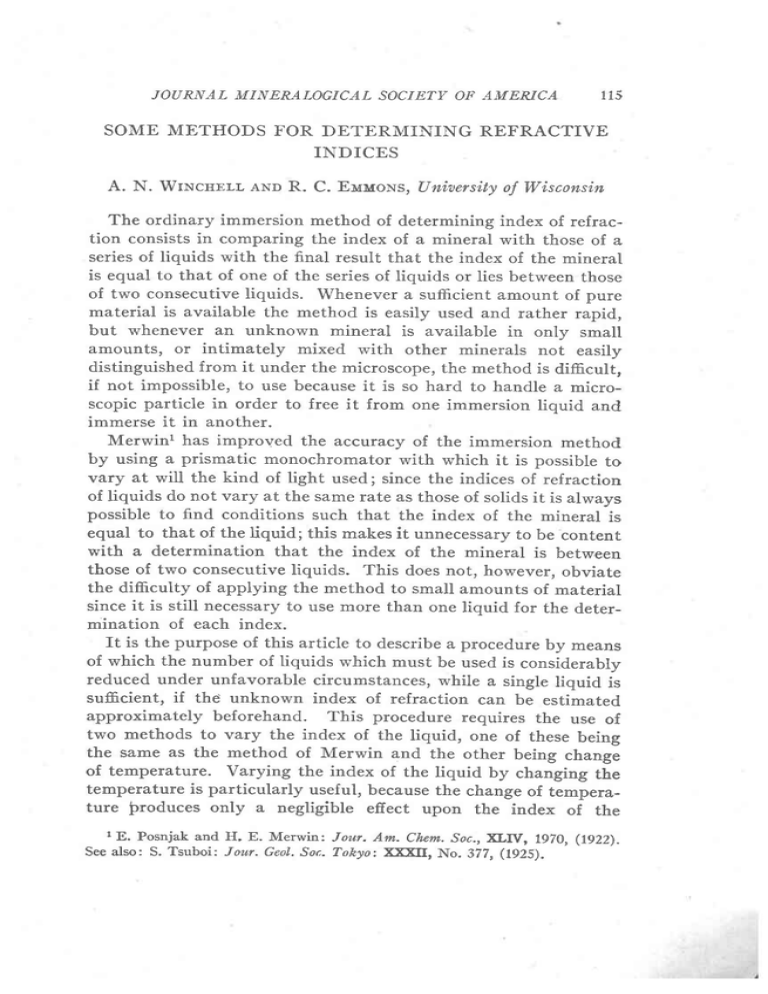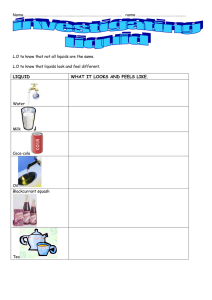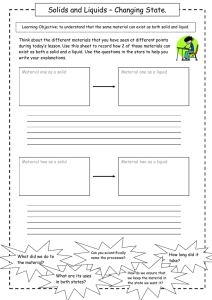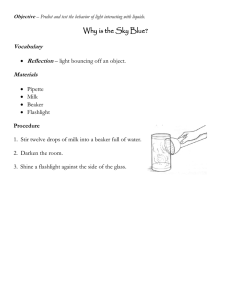some methods for determining refractive indices
advertisement

TOURNAL MINEKALOGICAL SOCIETY OF AMEruCA 115 SOME METHODS FOR DETERMINING REFRACTIVE INDICES A. N. WTNcHELLAND R. C. EuuoNs, Uni,aersityoJ Wisconsin The ordinary immersion method of determining index of refraction consists in comparing the index of a mineral with those of a series of liquids with the fi.nal result that the index of the mineral is equal to that of one of the seriesof liquids or Iies between those of two consecutive liquids. Whenever a sufficient amount of pure material is available the method is easily used and rather rapid, but whenever an unknown mineral is available in only small amounts, or intimately mixed with other minerals not easily distinguished from it under the microscope,the method is diffi.cult, if not impossible, to use becauseit is so hard to handle a microscopic particle in order to free it from one immersion liquid and immerse it in another. Merwinl has improved the accuracy of the immersion method by using a prismatic monochromator with which it is possible to vary at will the kind of light used; since the indices of refraction of liquids do not vary at the same rate as those of solids it is always possible to find conditions such that the index of the mineral is equal to that of the liquid; this makes it unnecessaryto be content with a determination that the index of the mineral is between those of two consecutive liquids. This does not, however, obviate the difficulty of applying the method to small amounts of material since it is still necessaryto use more than one liquid for the determination of each index. It is the purpose of this article to describea procedure by means of which the number of liquids which must be used is considerably reduced under unfavorable circumstances, while a single liquid is suficient, if thd unknown index of refraction can be estimated approximately beforehand. This procedure requires the use of two methods to vary the index of the liquid, one of these being the same as the method of Merwin and the other being change of temperature. Varying the index of the liquid by changing the ternperature is particularly useful, becausethe change of temperature produces only a negligible effect upon the index of the 1E. Posnjak and H, E. Merwin: Jour. Am. Chem. Soc., fr,I\I, lgZO, (lgl2). See also: S. Tsuboi: Jour. Geol, Soc. Tokyo:, xxxTr, No. 377, (1925). TH E A M ERIC A N M I N ERA LOGIST 116 mineral2 whereas change of wave-length produces an important effect upon the index of the mineral. The net result of this double method of varying the index of the liquid is that under favorable circumstances it is possible to determine accurately all the indices for sodium light of a single mineral grain (by turning it into various positions, if necessary) while immersed in a single liquid. The procedure is simple. A grain is mounted on a slide in which the temperature is known. Each index is read at two temperatures and at two wave-lengths and all four values are recorded. This is equivalent to measuring each index in two immersion media and at two wave-lengthsof light. llonoohroEetor prl.rr ?"toq ro.dlDgj oo i:' oo o o q q 0 F O oo R€frrctiea 1. Fig. Temperature lnaor Dispersion Diagram 2 Changes oi index of refraction for loC in units of the 5th decimal place, Te,enlr-aN.) D line. (Taken from L,txoorot-BonNsrrrN Fluorite Halite (exceptionally high) Sylvite @ Calcite G 1.11 3.70 3.46 .07 1.10 Quartz @ c ttAmorphous Quartz" .59 .70 t.02 IOURNAL MINERAI.OGICAL SOCIETY OF AMERICA tt7 On Merwin's diagram (Fig. 1) each liquid is plotted to show its dispersion. To this must be added sufficient data-in the form of the few extra lines shown on the diagram-to indicate the dispersion of each liquid through the temperature range possible on the instruments. The diagram is then used in a manner similar to that originally devised by Merwin, regarding the lines representing the dispersion of the liquids at different temperatures as equivalent to ]ines representing the dispersion of difierent liquids at room temperatures. By the use of this method, the number of liquids required to cover the range of refractive indices of common minerals is very much reduced, which means that the number of mounts that it is necessaryto make is reduced and much time is saved. fn studying soils, heavy residues,etc., many mounts may be examined before the desired mineral is found. It is then a very real satisfaction to be able to determine the constants of the grain and not to have to remount and search for it again. 19 \9 To l,lecta 5t Ege Fig. 2. Water Circulation Cell To obtain monochromatic light we use a smallLeitzmonochromator. This instrument does not give as limited a range of wavelengths as a larger instrument but it can be so adjusted when a final reading is to be made that the range is only a Iew prp in the red and is essentially monochromatic in the violet. On the whole is has been found quite satisfactory for this purpose. Refractive indices of liquids are read on a Spencer-Abb6refractometer which is on the same temperature control system as the microscopeand which usesthe same light as the microscope. When an immersion medium is changed on the microscope stage it is also changed on the refractometer. A simple curve supplied by the manufacturer of the Abb6 refractometer makes it adaptable to use with monochromatic light. 118 TH E A M ERICA N M I N ERA LOGI ST The object glass used was constructed for the purpose. It consists of a small rectangular metallic cell equipped with two tubesone for intake and the other for the outlet of circulating water, as shown in Fig. 2. On the lower side of the center of the cell is a glass plate of the thickness of ordinary object glasses. Directly above this is a round cover glass fixed in the upper side of the cell. The circulating water flows between these glass plates. The mount is placed directly on the cover glass and is covered by a quartersize cover glass. The purpose of the cover glass on the upper side of the cell is to place as little insulation as possible between the circulating water and the mount. The cell is mounted on a mechanical stage but this is not necessary. A pump serves to circulate the water. The water passes a thermometer, through the cell on the microscope, through the refractometer and by another thermometer. When the thermometer readings check the temperature of the system is assumed to be uniform. The temperature is not raised above 50"C because high temperatures are injurious to the refractometer. A range of 40" is then available and this has been found quite satisfactory. A small reservoir in the system contains a copper coil through which hot or cold tap water circulates-this gives excellent control of temperature. About one hundred liquids have been examined to obtain the best possible with respect to dispersion and temperature coeficients. More are to be examined before final selection of liquids will be made; we ofier none, therefore' at this time. Further modifications of the apparatus are being attempted in order to include the higher refractive indices, thereby overcoming the Iimitations imposed by the Abb6 refractometer. NOTES ON HORNBLENDE W. A. P. Gneneu, Uni.aersityof Minnesota VemntroNs rN TrrE CnBurcer CouposrrroN or HonNsLENDE rnou DilrBnBNr Tvprs or IcNBous Rocxs Certain petrographers have assumedl that the hornblendes from any given type of igneous rock have approximately uniform composition and have utilized this assumption in estimating the chemical composition of rocks. With a view of investigating the (f911)' I lddings,I. P.; RockMinerals, pp. 350-354




